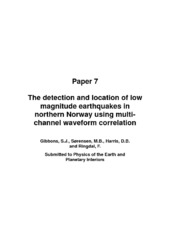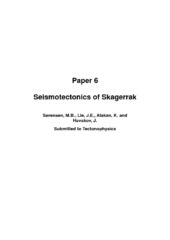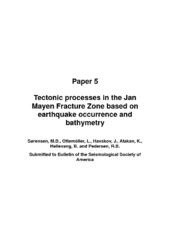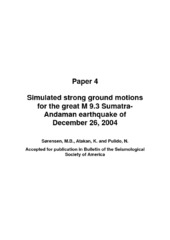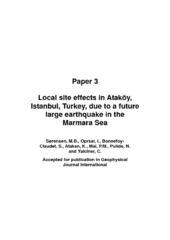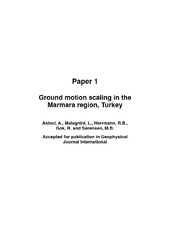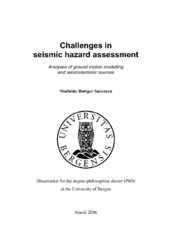| dc.contributor.author | Sørensen, Mathilde Bøttger | eng |
| dc.date.accessioned | 2006-07-16T12:17:31Z | |
| dc.date.available | 2006-07-16T12:17:31Z | |
| dc.date.issued | 2006-06-21 | eng |
| dc.identifier.isbn | 82-308-0190-8 | en_US |
| dc.identifier.uri | https://hdl.handle.net/1956/1555 | |
| dc.description.abstract | Seismic hazard assessment has an important societal impact in describing levels of ground motions to be expected in a given region in the future. Challenges in seismic hazard assessment are closely associated with the fact that different regions, due to their differences in seismotectonics setting (and hence in earthquake occurrence) as well as socioeconomic conditions, require different and innovative approaches. One of the most important aspects in this regard is the seismicity level and the pre-existing knowledge about seismotectonics and fault behaviour in the region. The present thesis focuses on seismic hazard in three regions of very different tectonics in which different approaches for seismic hazard assessment were needed. In seismically active regions, standard probabilistic and deterministic approaches can be followed in assessing the hazard provided that the seismotectonic and geological information is available. In regions of low seismicity, this information is often incomplete and it may be necessary to start by studying in more detail the seismotectonic processes giving rise to the seismic hazard. The Marmara Sea and Sumatra regions are the main geographical areas where challenges in high seismicity areas are addressed. For addressing the seismic hazard assessment in low seismicity areas, the approach was to focus on the seismotectonic source characterization in various locations in Norway and adjacent areas. The Marmara Sea region is under a significant seismic hazard due to the short distance to the North Anatolian Fault which is believed to be close to rupture. This region is well studied in terms of tectonics and fault properties. However, the attenuation properties of the crust in the region have been uncertain. A new attenuation relation is established for the region, based on regressions performed on the background seismicity (paper 1). The obtained relation shows good agreement with previously used relations. Due to the increased level of knowledge about the active faults in the Marmara Sea, scenario based ground motion modelling provides a reliable estimate of the seismic hazard due to a future large earthquake. The predictive nature of such computations leads to uncertainties in the input parameters, the effect of which has not been well known previously. A study of the effect of varying input source and attenuation parameters (paper 2) shows that rise time, rupture velocity, stress drop and rupture initiation point are the most significant parameters in terms of ground motion level. The effect of parameters and the variability of ground motion are strongly frequency dependent. Another factor leading to uncertainties in simulated ground motion is that most simulations are performed at bedrock level without taking possible site amplifications into account. This latter problem is addressed in a separate study in the Ataköy area, SW Istanbul (paper 3), which shows that site amplification is significant over the whole area with amplification up to a factor of 2. The December 26, 2004 Sumatra-Andaman earthquake left many unanswered questions regarding the importance of ground shaking in the observed damage and, more generally, the nature of ground shaking caused by very large earthquakes. To address these issues, the event is modelled in terms of ground motion to see the effect of ground shaking in the regions near the fault rupture (paper 4). Results show that ground shaking was significant in northern Sumatra and the neighbouring islands and set bounds on the ground motion to be expected from such large events. The low seismicity in Norway and the surrounding areas makes it difficult to understand the relationship between the tectonics (active faults) and the earthquake activity. In order to improve this, three regions of significant seismic activity have been chosen for further seismotectonic investigations. The Jan Mayen region is, with its location on the mid-Atlantic ridge, the seismically most active region in Norway. Despite this fact, very little was previously known with respect to active fault structures. Locations of a M=6.0 earthquake and its aftershocks, combined with a detailed bathymetry, have provided new evidence about active tectonic structures in the region (paper 5). It is shown that major strike-slip earthquakes occur along the Koksneset fault, which seems to be the dominant structure in the Jan Mayen Fracture Zone. In addition, NE-SW oriented normal or oblique normal faults are being reactivated in the Jan Mayen Platform as a result of the deformation along the Koksneset fault. Deformation along the plate boundaries is significantly different from intraplate deformation. In this sense, the tectonic setting of Skagerrak situated in a basin within the Eurasian Plate is very different from Jan Mayen. This is reflected in the seismicity, which is much lower than for Jan Mayen but still high in comparison to other regions in Norway. Most earthquakes here have magnitudes less than 3, which in combination with the offshore location makes earthquake location challenging. Increased station coverage during the recent years has improved the location capabilities and the combination of relocated seismicity with reinterpreted seismic profiles and gravity and magnetic anomaly data has provided new clues about the origin of the Skagerrak seismicity (paper 6). A previously unknown graben structure, the Langust fault zone, is found at a location coinciding with the location of the local seismicity. This structure is believed to be the source of a large part of the Skagerrak earthquakes. In addition, activity seems to be present along the Sorgenfri-Tornquist Zone, as it is also the case further southeast in Kattegat. The Rana region in northern Norway is unique in the sense that several earthquake swarms have been registered here earlier. The installation of two temporary stations in this active region has provided high-quality recordings of events down to magnitude less than 0.5. In addition to providing new information about the seismotectonics in the region, these events have been used as ground truth in calibrating event detection based on waveform correlation (paper 7). In combination, the presented studies address some of the challenges associated with seismic hazard assessment, and can hopefully serve as a basis for further investigations in the future. | en_US |
| dc.format.extent | 13308853 bytes | eng |
| dc.format.extent | 13165193 bytes | eng |
| dc.format.extent | 12423812 bytes | eng |
| dc.format.extent | 1484559 bytes | eng |
| dc.format.extent | 5464517 bytes | eng |
| dc.format.extent | 3231394 bytes | eng |
| dc.format.extent | 4954262 bytes | eng |
| dc.format.extent | 2137385 bytes | eng |
| dc.format.mimetype | application/pdf | eng |
| dc.format.mimetype | application/pdf | eng |
| dc.format.mimetype | application/pdf | eng |
| dc.format.mimetype | application/pdf | eng |
| dc.format.mimetype | application/pdf | eng |
| dc.format.mimetype | application/pdf | eng |
| dc.format.mimetype | application/pdf | eng |
| dc.format.mimetype | application/pdf | eng |
| dc.language.iso | eng | eng |
| dc.publisher | The University of Bergen | en_US |
| dc.relation.haspart | Paper 1: Ground motion scaling in the Marmara region, Turkey. A. Akinci, L. Malagnini, R. B. Herrmann, R. Gok and M. B. Sørensen. Accepted for publication in Geophysical Journal International. Published version available at: <a href="http://dx.doi.org/10.1111/j.1365-246X.2006.02971.x"target=_blank>http://dx.doi.org/10.1111/j.1365-246X.2006.02971.x</a> | en_US |
| dc.relation.haspart | Paper 2: Restricted due to publisher policy. Sensitivity of Ground-Motion Simulations to Earthquake Source Parameters: A Case Study for Istanbul, Turkey. Mathilde B. Sørensen, Nelson Pulido and Kuvvet Atakan. Submitted to Bulletin of the Seismological Society of America. Published version available at: <a href="http://dx.doi.org/10.1785/0120060044"target=_blank>http://dx.doi.org/10.1785/0120060044</a> | en_US |
| dc.relation.haspart | Paper 3: Local site effects in Ataköy, Istanbul, Turkey, due to a future large earthquake in the Marmara Sea. Mathilde B. Sørensen, Ivo Oprsal, Sylvette Bonnefoy-Claudet, Kuvvet Atakan, P. Martin Mai, Nelson Pulido and Caglar Yalciner. Accepted for publication in Geophysical Journal International. Published version available at: <a href="http://dx.doi.org/10.1111/j.1365-246X.2006.03204.x"target=_blank>http://dx.doi.org/10.1111/j.1365-246X.2006.03204.x</a> | en_US |
| dc.relation.haspart | Paper 4: Restricted due to publisher policy. Simulated Strong Ground Motions for the Great M 9.3 Sumatra–Andaman Earthquake of 26 December 2004. M. B. Sørensen, K. Atakan, and N. Pulido. Accepted for publication in Bulletin of the Seismological Society of America. Published version available at: <a href="http://dx.doi.org/10.1785/0120050608"target=-blank>http://dx.doi.org/10.1785/0120050608</a> | en_US |
| dc.relation.haspart | Paper 5: Restricted due to publisher policy. Tectonic Processes in the Jan Mayen Fracture Zone Based on Earthquake Occurrence and Bathymetry. Mathilde Bøttger Sørensen, Lars Ottemöller, Jens Havskov, Kuvvet Atakan, Bjarte Hellevang, and Rolf Birger Pedersen. Submitted to Bulletin of the Seismological Society of America. Published version available at: <a href="http://dx.doi.org/10.1785/0120060025"target=_blank>http://dx.doi.org/10.1785/0120060025</a> | en_US |
| dc.relation.haspart | Paper 6: Seismotectonics of Skagerrak. Sørensen, M.B., Lie, J.E., Atakan, K. and Havskov, J. Submitted to Tectonophysics. | en_US |
| dc.relation.haspart | Paper 7: The detection and location of low magnitude earthquakes in northern Norway using multi-channel waveform correlation at regional distances. Steven J. Gibbons, Mathilde Bøttger Sørensen, David B. Harris and Frode Ringdal. Submitted to Physics of the Earth and Planetary Interiors. Published version available at: <a href"=http://dx.doi.org/10.1016/j.pepi.2006.11.008"target=_blank>http://dx.doi.org/10.1016/j.pepi.2006.11.008</a> | en_US |
| dc.title | Challenges in seismic hazard assessment: Analyses of ground motion modelling and seismotectonic sources | en_US |
| dc.type | Doctoral thesis | |
| dc.subject.nsi | VDP::Matematikk og Naturvitenskap: 400::Geofag: 450::Faste jords fysikk: 451 | nob |
